People
Meet Kris Lemsalu, the Eccentrically Costumed Artist Who Will ‘Give Birth to a World of Shamanic Force’ at the Venice Biennale
Lemsalu will team up with friends, including the artist Sarah Lucas, to create her own world on a Venetian island.
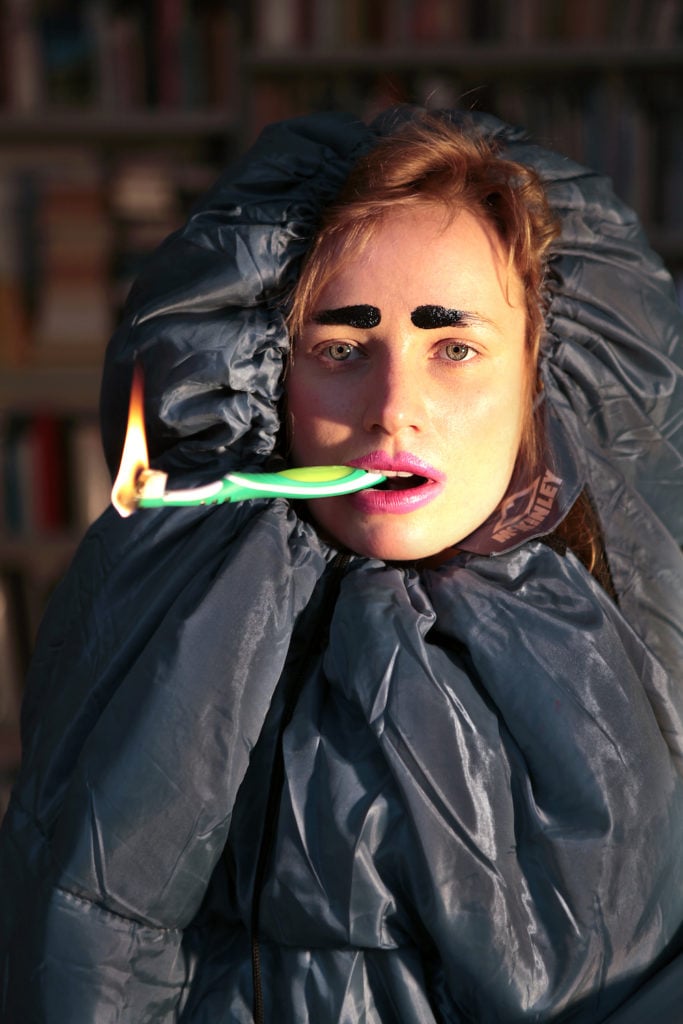
Lemsalu will team up with friends, including the artist Sarah Lucas, to create her own world on a Venetian island.

Kate Brown

The first time I meet artist Kris Lemsalu, she is wearing a Medusa-like piece of rubber headgear, makeup reminiscent of a Russian nesting doll, and a vibrantly-colored old pantsuit that once belonged to a Bolivian witch.
You might not know exactly what she looks like, because her likeness is constantly shifting. But you know her when you see her. The same goes for her practice, which is a meandering blend of performance, ceramic sculptures, and theatrical multimedia installations.
The Estonian artist’s introduction to American audiences came in the form of a performance at Frieze New York back in 2015, when she lay prone inside a 220-pound ceramic turtle shell for hours on end. Her limbs dangled out from the massive sculpture while she lay face down on a waterbed. It was a fitting debut: for Lemsalu, the lines between her own body and her art, found objects and performance, as well as fantasy and reality, are all extremely blurry.

Kris Lemsalu’s Whole Alone II performance and installation at Frieze New York 2015. Courtesy Temnikova & Kasela and Piibe Kolka.
But whether in regalia or hiding under a tortoise shell, just a few years ago, Lemsalu was little known beyond a few privileged art circles in continental Europe. But in a tired-out art world, Lemsalu’s mixture of fantasy is like an imaginative antidote. To quote LA-based art critic and curator Andrew Berardini in his reflection on Lemsalu’s work: “In the middle of the thrum and cacophany of industry trading, of flashy luxury goods mixed with authentic heart songs all for a price, who wouldn’t want to turtle?”
Last year, the sculptor-as-performance-artist presented back-to-back solo shows at the historic Vienna Secession and at the new Goldsmiths Centre for Contemporary Art in London. In 2017, she blew audiences away with a live performance that melded sculpture, video, and sound at Performa in New York and then at the David Roberts Foundation in London.
Soon, Lemsalu will welcome an ever wider audience into her fairytale storybook. She is currently preparing to represent Estonia at the Venice Biennale, which opens May 11.
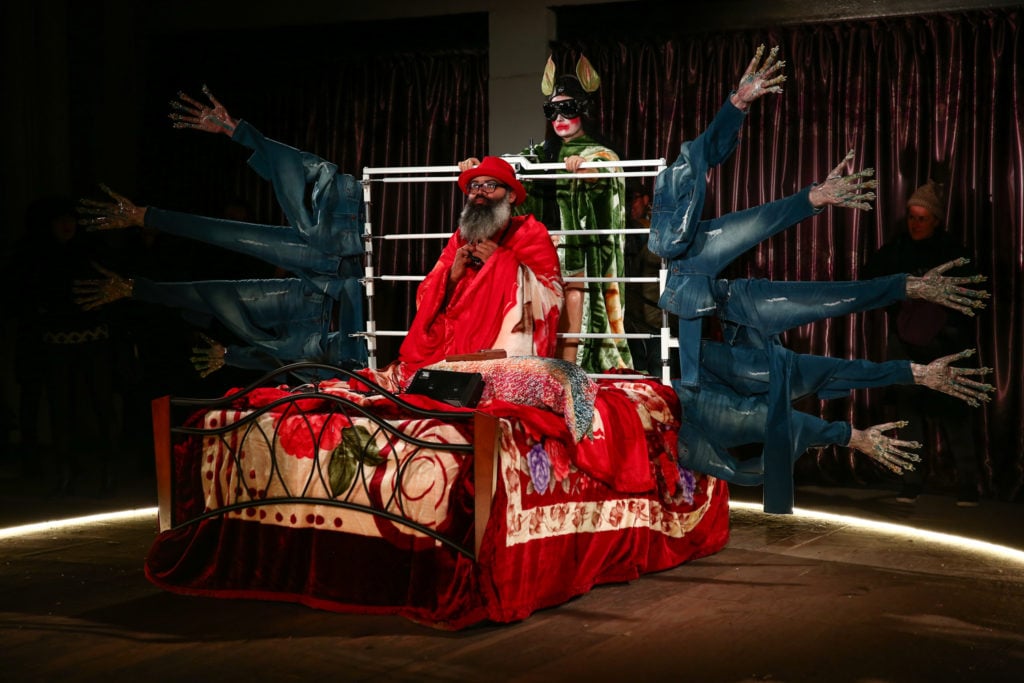
Performa 2017. Photo: Paula Court
Lemsalu is keeping the particulars of her Venice project under wraps. But as usual, she will be doing things on her own time and in her own way. While her previous works’ major thematic was death, for “BIRTH V” in Italy, the inception of life will be the Lemsalu’s wide-open, awe-inducing topic for Lemsalu. (though her press release points out that death is never far away— it “wears a carnival mask in Venice anyway”).
She has dispensed with the tradition of inviting a local curator to organize the presentation, instead opting to assemble an international troupe of friends to help build the show, including artist Sarah Lucas and art critic Andrew Berardini. Irene Campolmi, a Copenhagen-based curator, and Tamara Luuk, an old friend and contemporary art curator at Tallinn Art Hall, will also be by her side, as well as musicians.
“It becomes more and more about the people I am working with, and about how we work together and build a family structure,” Lemsalu tells me over Skype from her home in Tallinn. She is sitting beside a fireplace, occasionally stoking it. Estonia, one of the more northern countries in Europe, experiences radical extremes of darkness and light. (Around the time we spoke this winter, the sun had risen just before 9:30 a.m. and was setting shortly after 3 p.m.)
Lemsalu’s global network of friends, whom she calls family, are something of a remedy to the remoteness of Tallinn. They also provide a tether for an artist whose work seems to exist in a fantasy world. A few times a year, she brings friends and members of her local production team to Hiiumaa, an Estonian island where she produces her impressive porcelain ceramics.
For Lemsalu, the sparse island is a special place. She fires her ceramics inside an old wood-fired kiln in a workshop that only operates during the spring and summer. Each person she brings along does an eight-hour shift, chopping wood and warming the kiln up from zero to around 2370 degrees Fahrenheit (that’s 1,300 Celcius).
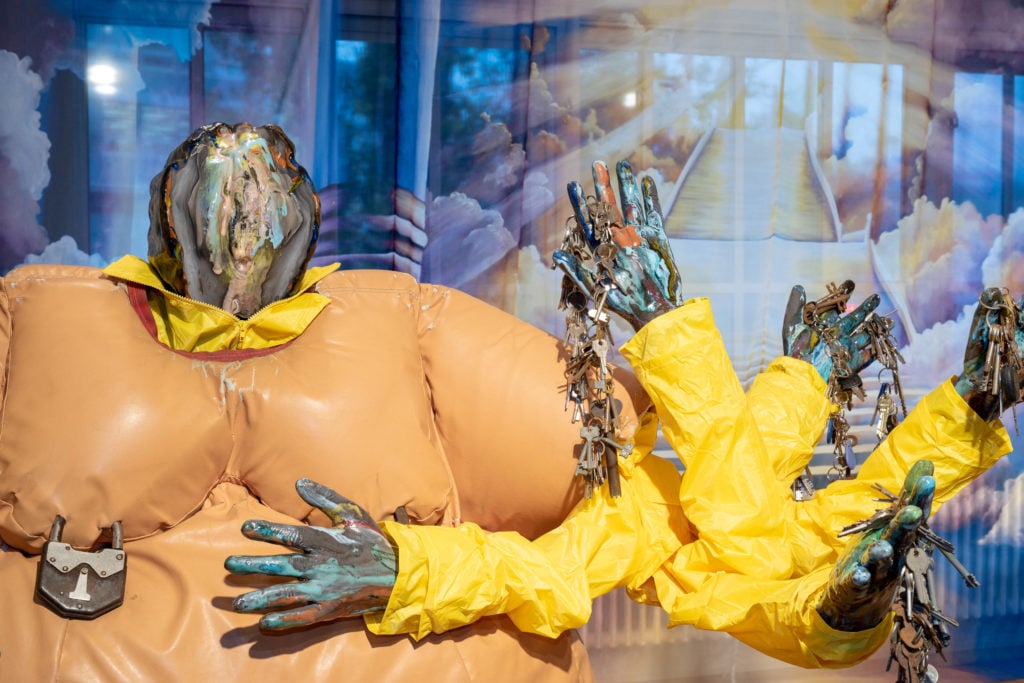
Kris Lemsalu Keys Open Doors at Secession in Vienna. Photo: Maximilian Anelli-Monti. Courtesy of the artist and Temnikova & Kasela Gallery.
The time-intensive firing process is part of what keeps Lemsalu coming back to this place. “You are there alone mostly, and I always take the night shift from midnight to morning,” she says. “I experience the light changing, the time passing.”
Appropriately, her Venice presentation will also take place on an island—Giudecca, one of the remote masses that surrounds the floating city. This marks the first year the Estonian pavilion has been held there, inside an old woodworking shop that is still family-run. It’s a short boat ride away from Venice, but especially during the frenzied opening days, it feels like it is a world apart.
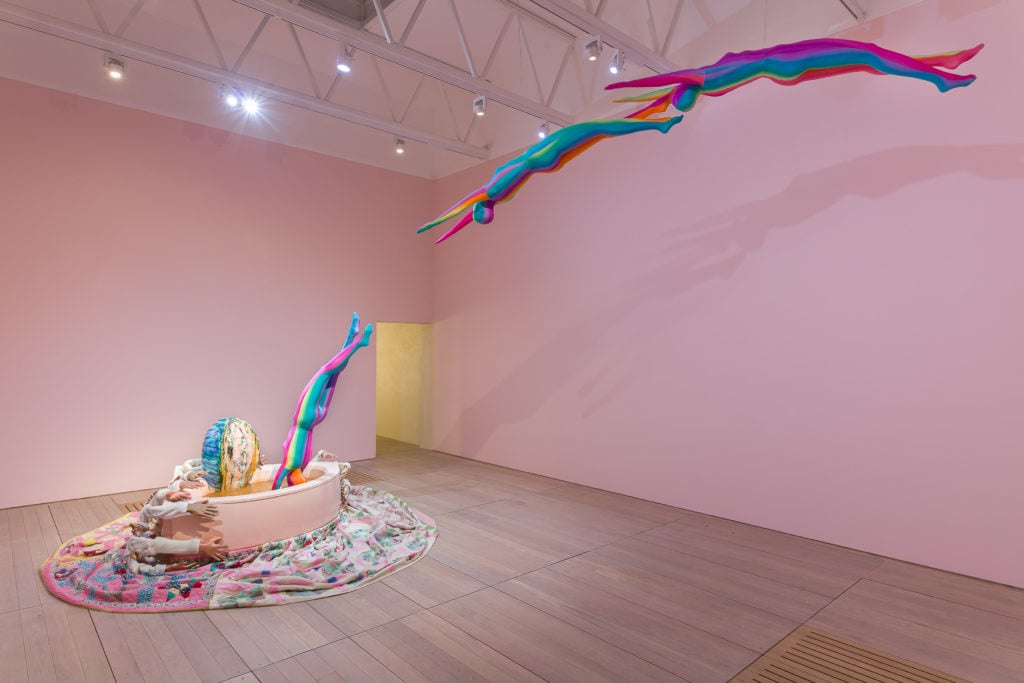
Goldsmiths CCA. Photo: Mark Blower.
Growing up in post-Soviet Tallinn, Lemsalu started dressing up at 15, in the early 2000s, when she began going to an Estonian factory rave, a kind of Eastern European twist on Studio 54.
“There was a secret upstairs room where often one or two artists would curate a topic, a dress code, fashion shows, or performances,” she recalls. “And I began developing a character there where I felt there was room to play. But I don’t take myself seriously. It’s much more fun to dress up. I can choose whatever character.”
She went on to study ceramics and design at the Estonian Academy of Arts, the Royal Danish Academy of Fine arts in Copenhagen, and the Academy of Fine Arts Vienna. Her sculptures and environments often include animal pelts, clothing, and food arranged around her impressively large scale ceramic objects. And just as she becomes a character within her art, her installations often feature headless or floating bodies, or made-up creatures.
Years after she first put on a costume, Lemsalu continues to approach dressing up as an opportunity to tell a story or create a life. She originally discovered the Bolivian witch outfit she had on when we first met buried under textiles at a thrift store. She imagines its original witch owner chewing on coca leaves as she wore it, with green saliva dripping down his chin and onto his front.
When she encounters an object like this, Lemsalu says, she feels a powerful urge to preserve it. “I fear that if I get rid of such things, the memory of this person will disappear,” she says. She doesn’t feel particularly proud of this sentimentality, so she wears the objects around to avoid becoming a “hoarder.”
Similarly, the artist feels protective of the sculptures she makes, which she occasionally embodies or interacts with. “Sometimes a work just needs the presence of my body in order to continue living alone afterwards,” she tells me about her performances. “It’s some kind of encouragement for them or an initiation. They will continue living without me.”
It’s tempting to connect her interest in storytelling and preserved histories to her upbringing in a country whose history before it gained independence in 1991 is easily fascinating to the Western world. But Lemsalu isn’t interested in a biographical interpretation of her work. “I am always kind of escaping from labels,” she says. “I have roots and, even though I would like to be this intergalactic traveler, of course there are major influences through how I grew up.”
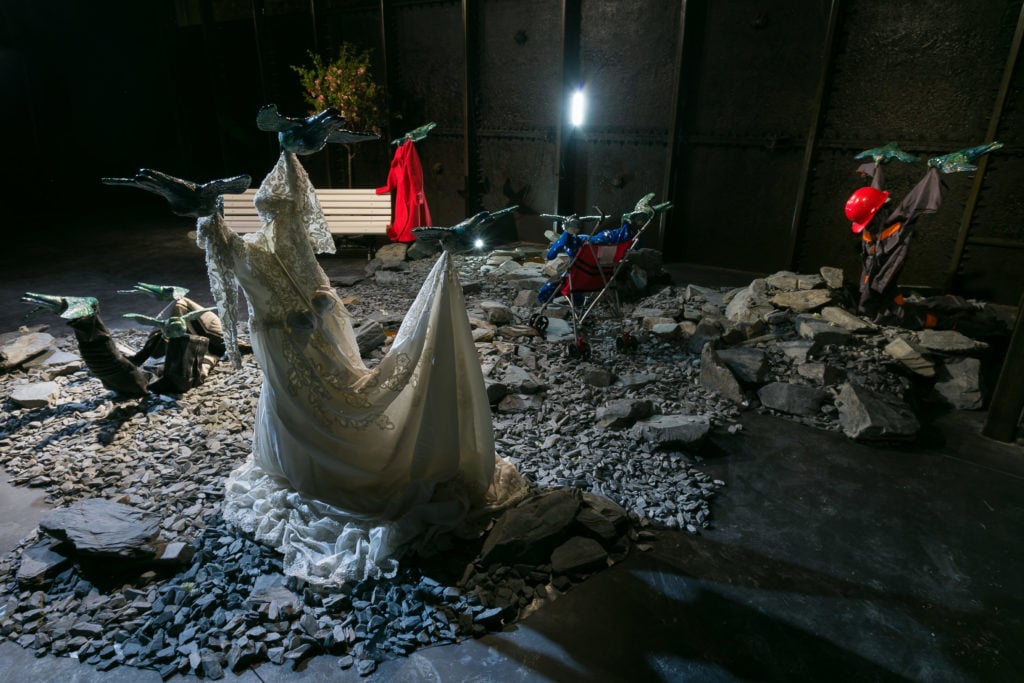
Goldsmiths CCA. Photo: Mark Blower.
Like her costumes, Lemsalu’s art pulls you in with its exuberant, wild colors, and curious forms—and then it leaves you feeling a little uneasy. At her Goldsmiths exhibition at their new CCA, a mess of legs kick out from underneath a bright pink duvet and crawl across the walls. In another room, rainbow bodies soar overhead and dive into a pool surrounded by a pastel quilts.
But as you look closer, that pool, filled with murky liquid, begins to feel more ominous. In another room, birds hold up empty clothes, from a soiled wedding dress to a safety jacket. Lifeboats, helmets, parachutes, and sleeping bags are recurring motifs, calling to mind the escalating crisis over migration worldwide. It’s as if Lemsalu is trying to create a shelter for her characters, to give them safe passage into another world.
I ask if her clothes also serve as protective armor for her own growing presence in the art world. She seems to agree. “I don’t know when it will all disgust me to the point that I will make teacups, and be happy with that,” she says. “I am trying to just put everything into what I am doing now and get good people on board. I will run with my idealism until it runs out.”
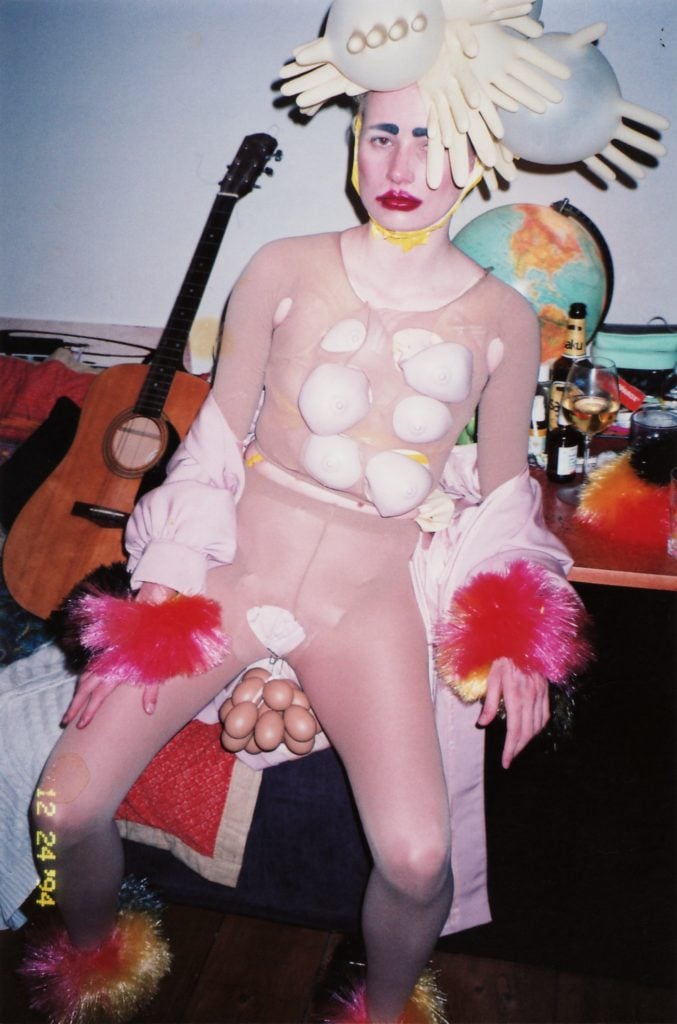
Kris Lemsalu by Johanna Ulfsak.